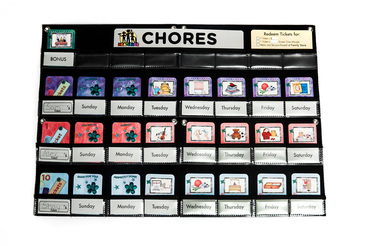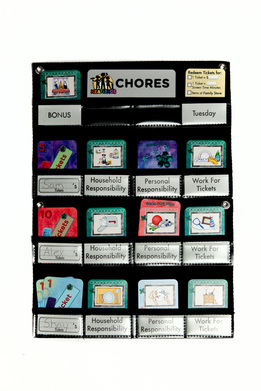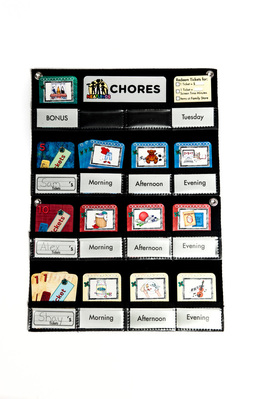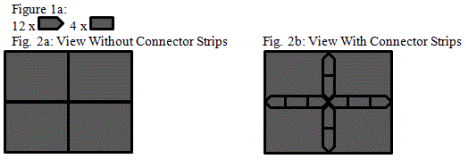|
Vertical Divider
Parents select choresParents select the chores for their kids and mark if it is a Responsibility or if the child can Work For Tickets!
|
Vertical Divider
Kids do chores and earn ticketsKids complete their Responsibility chores to earn the right to earn tickets for their Work for Ticket chores.
|
Vertical Divider
Kids redeem ticketsKids cash their tickets in:
|
STEP: |
CHOOSE NEATLINGS CHORE CHART CONFIGURATIONThere are several ways that you can configure your NEATLINGS Chore Chart. Below are a few configurations which are shown for 3 children but can be easily adjusted for less or more children.

Chores by Week:
Top Row – Place your title cards. Second – Fourth row

Chores by Priority: This option is best suited if you need to prioritize chores. You will not need all your chart panels for this option.
Top Row – Place your title cards. Second – Fourth row

Chores by Time of Day: This option is best for chores that need to be completed at specific times throughout the day. This option takes up less wall space and may be best suited for homeschooled children or home throughout the day. You will not need all your chart panels for this option.
Top Row – Place your title cards. Second – Fourth row
Click here for more Chart Configuration Ideas for 1-6 kids.
Will open in new window. |
STEP: |
CONFIGURE NEATLINGS CHORE CHARTNow that you've decided on your configuration it is time to connect your chore chart panels use the included hook strips (Figure 1a). Simply turn over the chart panels and arrange them in the configuration you choose. Connector strips come in two sizes; for the vertical connections you will need two bullet nosed strips and for the horizontal connections you will need two bullet nosed strips and a double straight edge strip. Refer to examples Figures 2a and 2b. There are several other configurations that could be chosen as well.
Note: If this is your first pocket chart from NEATLINGS then you will not use all of your hook fabric strips. Extras are included to accommodate different configurations and to attach additional sets of NEATLINGS charts.)
PLACE TITLE CARDS
|
STEP: |
IMPLEMENTING NEATLINGS CHORE CHART
|
TIP: One settle-up option that is very effective, is to only pay for the chore cards that are selected as Work For Tickets only if all the Personal Responsibility and Household Responsibility chores have been completed.
PUTTING IT IN ACTION
Example: A parent decides to pay their child 1 ticket per completed chore however if all four of the chores are completed for that day without complaint they agree to double the tickets earned per chore. The child does all the chores without complaint and earns a total of 8 tickets for that day. Now for this example the parent is willing to pay .25 cents per ticket or they can each be used for 15 minutes of screen time. This child decides to use 6 tickets for 1.5 hours of screen time.
Each day the child does the same thing. At the end of the week the child earned 56 tickets by doing 28 chores without complaint, redeemed tickets for 10.5 hours of screen time, purchased a lollipop and a can of play dough at the family store and pocketed $2.50
WOW! Twenty-eight more chores in a week and it cost you less than a good cup of coffee! Your child feels great about what they’ve accomplished, possibly spent less time on a screen, are learning new skills, and how to manage time and money!
Here is what your child gets out of the system and why they love it!
Each day the child does the same thing. At the end of the week the child earned 56 tickets by doing 28 chores without complaint, redeemed tickets for 10.5 hours of screen time, purchased a lollipop and a can of play dough at the family store and pocketed $2.50
WOW! Twenty-eight more chores in a week and it cost you less than a good cup of coffee! Your child feels great about what they’ve accomplished, possibly spent less time on a screen, are learning new skills, and how to manage time and money!
Here is what your child gets out of the system and why they love it!
- Kids love to learn and want to contribute. When they learn how to do new things they gain self confidence and a can do spirit.
- This program gives children a way to earn rewards while contributing to the family unit.
- When kids get bored and don’t know what to do, this gives them something constructive and meaningful to do.
- Kids can get frustrated by the lack of control they have over their day. This program allows them to have more control. It empowers them with the ability to manage their own earnings and screen time (within the parents set parameters).
FAMILY STORE
The store should be filled with items that are exciting for your kids. You can put anything in the family store. Have a variety of items and things worth even one ticket so that every child, even if short on tickets, will have the resources to purchase something and feel good about what they earned. For store bought items I recommend selling the items in the family store for ticket values equivalent to real life cost. You can also add in things like a trip to the park, ice cream shop, play date, movie night etc. Be sure to fill your store with a few items that will motivate each child at variable price points. You could even do group items that all the kids need to save for together like a trip to the zoo or a new game for the family gaming system.
|
Examples of items for family store.
1 Ticket = A lollipop or extra book at bedtime 2 Tickets = A small bottle of bubbles or picks the family board game 3 Tickets = A coloring book or later bedtime 4 Tickets = Anything from the dollar store or get to pick what's for dinner 20 Tickets = A book that cost $5 at store or a playdate 28 Tickets = Doll that cost $7 at store or a sleep over 40 Tickets = A small toy that costs $10 at store or a date night with mom or dad 60 Tickets = A medium toy set that costs $15 at store or go to a movie 120 Tickets= A game for a home system that costs $30 at store or trip to zoo |
Click here for more family store ideas. 99 Ideas for your family store.
Will open in new window.
Will open in new window.
- A family store can be as simple as a list kept in the pocket of the chore chart or a box kept up high in the closet filled with fun things.
- Also, know that family store items do not need to be things that cost money. Family bike ride, a walk to the park, a playdate are things that will motivate all kids! One NEATLINGS parent lets her kids redeem tickets for fishing time. Be creative and have fun with it!









